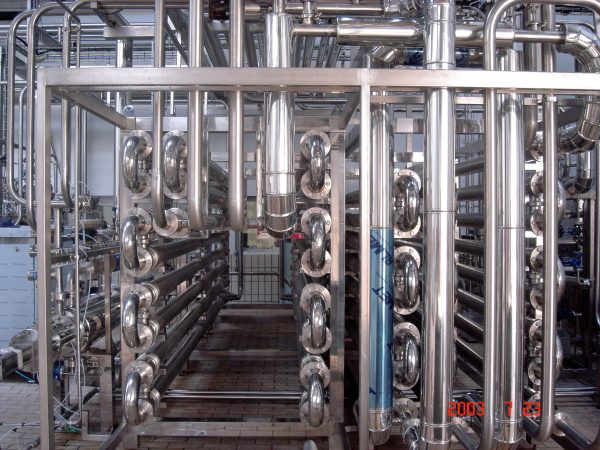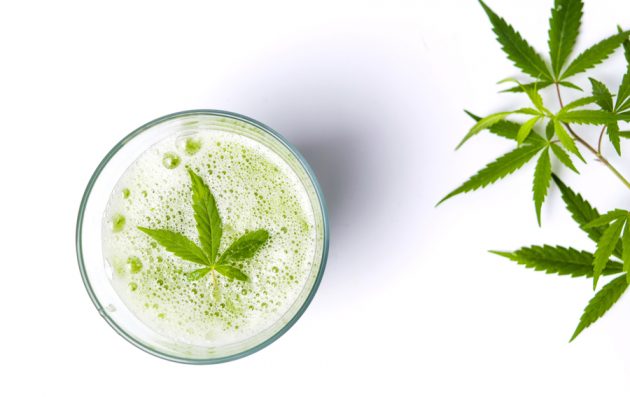
Cannabis drinks market scales up
By Matt Hale
equipment Beverages cannabis Editor pick Food production functional beveragesHeat exchangers can play a key role in the manufacture of cannabis-infused drinks
 Heat exchangers are crucial in beverage manufacturing facilities. Photo courtesy HRS Heat Exchangers
Heat exchangers are crucial in beverage manufacturing facilities. Photo courtesy HRS Heat Exchangers Functional drinks and drinks based on plant extracts—in particular, those containing cannabis- or hemp-derived ingredients like cannabidiol (CBD)—are one of the fastest growing segments in the beverage category.
As with any new market, there are several startup companies without a food manufacturing background. However, while some of the hype around the market and the products is reducing, there is no doubt about the potential for profit.
Those companies which want to have long-term success will need to efficiently scale-up production while maintaining the physical and chemical characteristics which make their products unique and desirable. Learning from existing beverage manufacturers about the best processing options for pasteurization, cooling or filling will be essential to achieving prolonged success.
What is CBD?
CBD is a chemical extracted from hemp and marijuana plants (Cannabis sativa L.). While CBD is an active ingredient in cannabis, it does not cause the “high” or psychoactive effects associated with the chemical THC (tetrahydrocannabinol), which is also found in the plants.
CBD used for food and drink products is usually taken from hemp oil due to the lower levels of THC. Although medical studies are inconclusive, some of the claimed benefits of CBD include reducing inflammation, improving relaxation and better focus. With so much potential, it is easy to see why many are hailing hemp as the next superfood.
In general, the term hemp refers to low-THC forms of cannabis, which are still capable of producing CBD and other cannabinoid compounds, as opposed to high-THC forms, commonly known as marijuana. As well as referring to the botanical name of the plant, the term cannabis describes a drug which contains numerous compounds including CBD and THC. For product manufacturers and developers, the challenge is to provide the positive benefits of CBD without the other negative effects of cannabis.

Drinks based on plant extracts are one of the fastest growing segments in the beverage category. Photo © Creative-Family/ iStock/ Getty Images Plus
Market opportunities
Around the world projected valuations for the recreational CBD products (as opposed to medical markets) have recently been revised downward as investors begin to workout which startups are feasible long-term businesses and which have no experience and no revenue. However, the demand is clear. For example, in U.S. states where cannabis is legal for recreational use, drinks make up 15 per cent of purchased cannabis products, and around the world one-in-four consumers say they would be willing to try cannabis-infused drinks.
However, even with such healthy scepticism, the global cannabis drinks market is predicted to treble in value by 2024, reaching US$1.82 billion by the end of 2020, and US$5.8 billion within four years. This growth is seen across every segment of the drinks industry, from alcoholic drinks to wellness beverages and everyday drinks like tea and coffee. Large global brands including AB InBev and Molson Coors have announced plans to produce CBD-containing products, and while the global impacts of COVID-19 have slowed some aspects of product development and marketing, there is no doubt that a huge market remains untapped.
Entering this market is not for the faint-hearted. Different stages of market development, recognition, and approval around the world present challenges to the development of a large market with common standards. The limitations and prohibitions on different products in different countries (and even states) prevent the export of even successful products from one region to another without meeting a whole new range of tests and approvals, but despite the difficulties, legislation and licensing requirements around the world things are becoming clearer all the time and several consultancies operate in different countries to provide help and advice.
Technical challenges
Not all marketing focuses on the cannabis and CBD associations, with some manufacturers simply referring to their products as containing “hemp seed extracts,” possibly in a bid to emphasize the natural associations of their product. However, CBD extraction and isolation are usually industrial processes and many of the functional ingredients which are produced are not soluble.
To overcome this, it is necessary to produce an emulsion, which requires careful handing during processing. Traditional high-pressure homogenization is suitable for products where clarity is not an issue, but for infused waters and similar drinks, a number of proprietary “nano technologies” have been developed to create stable products.
The technical challenges do not just revolve around the issues of product formulation. The exact nature of the compounds found in the plant, and which can be extracted, can vary according to the growing environment of the plants and how they are processed. In some countries, such as Canada, product approval is dependent on being able to prove product consistency, something which is often easier said than done. Product stability is another area where care needs to be taken. Other regions, such as Europe, classify products a novel food and so stability of the product from manufacturer to consumption must be proven.
Scaling-up production
Heat exchangers play a key role in the manufacture of many beverage products, and cannabis infused drinks have the same requirements for pasteurization, sterilization, cooking or cooling as any other beverages which contain specific ingredients.
High-Temperature, Short-Time (HTST) pasteurization techniques help to preserve the flavour and texture (including the crucial emulsion) of many drinks, while cooling can involve chilled water or specific materials such as glycol.
Evaporation using heat exchangers is also an efficient method of concentrating products to achieve the required formulation.
Recapturing and reusing heat from other sources (such as surplus heat from cooling operations or spare boiler capacity) can be an effective way of increasing capacity or adding a new production process without the need for major new heating or energy infrastructure. Depending on the application, heat exchanger equipment can recover as much as 50 per cent of previously wasted heat, which can then be used for water, space or process heating, waste treatment or other thermal applications.
The type and model of heat exchanger will depend on many different factors, such as the nature of the process to be carried out (pasteurization, sterilization, dehydration, etc.) and the viscosity of the drink being processed.
It is best practice to seek out professional help from companies and conducte a thorough review of the complete range of available products, from simple tube-in-tube designs to reciprocating scraped-surface designs, all of which combine efficient heat transfer with delicate product handling. This ensures that the products remain in emulsion and also that the processing process does not foul the equipment.
Matt Hale is the international sales and marketing director for HRS Heat Exchangers.
This article was originally published in the May 2021 issue of Food in Canada.
Print this page